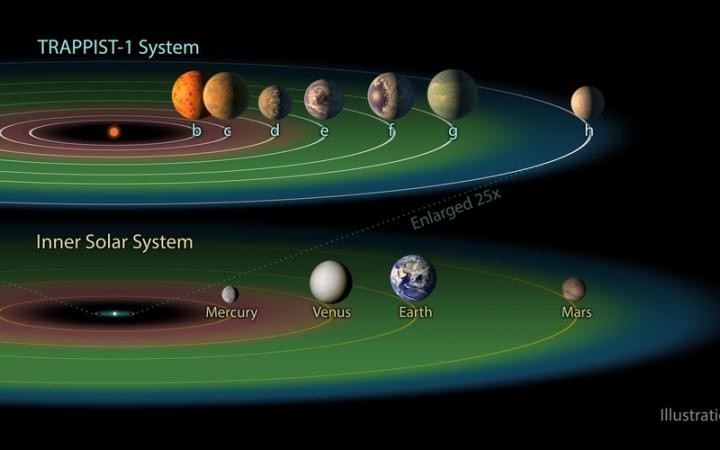There are strikingly close densities on the seven rocky planets circling the red dwarf star TRAPPIST-1, situated around 40 light-years away. This related property offers clues as to their structure.

TRAPPIST-1 is home to the largest population in a single planetary system, with nearly Earth-sized planets ever discovered. Previous estimates also said that the planets are about the Earth's size and density and would also be rocky or terrestrial, like Jupiter and Saturn, compared to gas-dominated. The latest article, reported in the Planetary Science Journal, provides the most reliable density measurements for any exoplanet community to date.
The further correctly scientists perceive the mass of a world, the more constraints they can set on its structure. The densities in our own solar system's eight planets differ significantly. The seven planets of TRAPPIST-1 have identical densities, with values varying by no more than three percent.
Seven planets from TRAPPIST-1 have a common structure, far distinct from that of the Earth's
According to NASA, these planets' same mass contains the same structure and ratio of materials such as silicon, iron, oxygen, and magnesium.
According to a release about the study, the exoplanets are approximately 8 percent less compact than Earth. About 5 percent of each planet's mass will have to remain as surface water for the world's lower density to be the product of surface water.
That's too many! In contrast, water accounts for only 0.1% of the mass of the Planet. And you will see straight away that these planets are very distinct from the Planet in terms of structure.
ALSO READ: Aliens From Almost 1,000 Nearby Stars Could Be Looking Straight Back at Us
Spitzer roamed across the system for over 1000 hours before its decommissioning mission in January 2020. To research the solar structure, NASA has used much of the resources using the Hubble and Kepler.
When scientists examined the results, they concluded that the seven TRAPPIST-1 planets might indeed have a very slight gap with each other, which is as small as three percent.
The disparity is around eight percent between certain planets and Earth, said to be large globally. TRAPPIST-1 planets may have lower iron densities, with a density of about 21 percent compared with 32 percent on Earth speculated by the report. The research even theorizes that there might not be strong iron centers on the planets. NASA agrees that a mixture of both possibilities, including any oxidized iron, might be the solution.
On a global scale, as contrasted with planet Earth, the disparity is huge. The eight percent gap indicates that there could be lower iron densities for the TRAPPIST-1 planets. Their iron density may be about 21 percent relative to that of the Planet, as the study finds. In comparison, the analysis also finds that there may be strong iron cones on the planets. They also recommend that any oxidized iron is found.
How They Got The Data
Statistical models collected by the Spitzer Space Telescope following the star system's detection more than four years ago have rendered the research possible. Spitzer reported 1,075 hours of observation time for TRAPPIST-1 between 2016 and 2020 when the telescope was decommissioned and started collecting results. Although Spitzer's decommissioning has placed a hold on observations, the TRAPPIST-1 studies do not represent a permanent end.
Suppose the James Webb Space Telescope would be deployed and commissioned later this year, scientists could begin observing the transits and try to track propagation spectroscopy atmospheres. A timing would be given for each passage, so we will begin to refine the planets' masses.
Check out more news and information on Space on Science Times.
© 2025 ScienceTimes.com All rights reserved. Do not reproduce without permission. The window to the world of Science Times.












